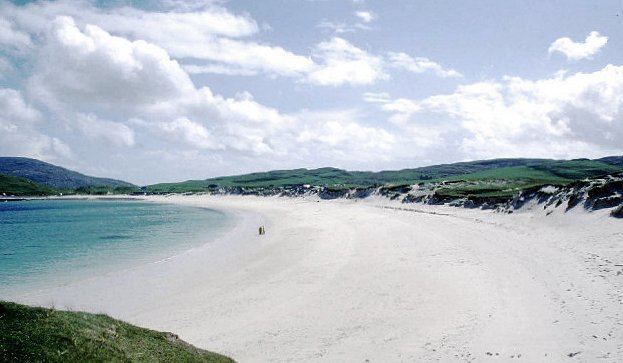Meaning of name Water island Area rank 51 Area 9.6 km² | OS grid reference NL635955 Highest elevation 190 m Council area Comhairle nan Eilean Siar | |
 | ||
Gaelic name Bhatarsaigh (help·info) Island groups British Isles, Outer Hebrides | ||
The vatersay boys at glasgow barrowlands
Vatersay (Scottish Gaelic: Bhatarsaigh, [vaʰt̪əɾs̪aj]) is the southernmost inhabited island in the Outer Hebrides of Scotland. Vatersay is also the name of the only village on the island.
Contents
- The vatersay boys at glasgow barrowlands
- Map of Vatersay United Kingdom
- Location
- Wildlife
- Archaeology
- Wrecks
- References
Map of Vatersay, United Kingdom
Location
Vatersay is also the westernmost permanently inhabited place in Scotland and in Great Britain. It is linked to the larger island of Barra by a causeway about 200 metres long and completed in 1991. At low tide, the island is also linked to the islet of Uineasan to the east.
Wildlife
Wildlife on the island includes otters, seals and herons. Bonnie Prince Charlie's flower (Calystegia soldanella), reputedly originating from French seeds dropped by Bonnie Prince Charlie is, in Scotland, found only on Vatersay and Eriskay.
Archaeology
The island has remains of an Iron Age broch at Dun a' Chaolais overlooking the Sound of Vatersay and nearby is a passage grave dated to the 3rd millennium BC. There is also a Bronze Age cemetery at Treasabhaig south of the heights of Theiseabhal Mòr and a cairn built circa 1000 BC west of the village of Vatersay. The offshore islet of Biruaslum has a walled fort that may be of Neolithic provenance.
Wrecks
One of the saddest events to befall the island happened when the Annie Jane, a three-masted immigrant ship out of Liverpool bound for Montreal, Canada, struck rocks off West Beach during a storm in September 1853. Within ten minutes the ship began to founder and break up casting 450 people into the raging sea. In spite of the conditions, islanders tried to rescue the passengers and crew.
There were only a few survivors. A small cairn and monument marks the site where the bodies recovered from the sea were buried. An inscription reads:
On 28th September 1853 the ship Annie Jane with emigrants from Liverpool to Quebec was totally wrecked in this bay and threefourths of the crew and passengers numbering about 350 men women and children were drowned and their bodies interred here.
Two Chinese seamen from the SS Idomeneus, which sank on 28 September 1917, are also buried somewhere near the monument. There is a commemorative headstone in Cuier Churchyard.
The remains of a Catalina flying boat that crashed on the slopes of Heishival Beg in 1944 lie in a stream bed near the shore.
